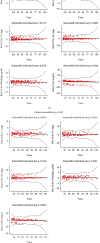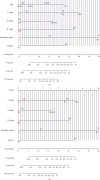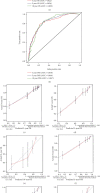Clinical Prediction Nomograms to Assess Overall Survival and Disease-Specific Survival of Patients with Salivary Gland Adenoid Cystic Carcinoma
- PMID: 36072473
- PMCID: PMC9444442
- DOI: 10.1155/2022/7894523
Clinical Prediction Nomograms to Assess Overall Survival and Disease-Specific Survival of Patients with Salivary Gland Adenoid Cystic Carcinoma
Abstract
Aim: Salivary gland adenoid cystic carcinoma (SACC) is the second highest incidence of malignant salivary gland tumor. The purpose of this study was to establish nomograms combined with SACC patients based on the Surveillance, Epidemiology, and End Results (SEER) database.
Methods: Patients with SACC were included in the SEER∗Stat Database from 2004 to 2016. The least absolute shrinkage and selection operator (LASSO) Cox regression analysis was applied to filter potential prognostic clinical variables. Multivariate analysis from the Cox proportional hazards model was performed to determine the independent prognostic factors on overall survival (OS) and disease-specific survival (DSS), applied to develop nomograms. The Schönfeld residual test verified the proportional hazard assumption. The discrimination and consistency of nomograms was assessed and validated according to concordance index (C-index), receiver operating characteristic (ROC) curves, and calibration curves using an internal 1,000 times bootstrap resampling. The nomogram's net clinical benefit was assessed through decision curve analysis (DCA).
Results: A total of 658 patients with SACC were included. Age, T stage, N stage, M stage, histologic grade, and surgery were independent prognostic factors for OS and DSS. Based on these independent prognostic factors, nomograms were developed to predict 3-, 5-, and 10-year OS and DSS. In the validation of 1,000 times bootstrap resampling, the C-index and ROC curves had good discriminatory ability. The calibration curves indicated excellent consistency between the predicted and actual survival results in the nomograms. The DCA curves demonstrated that the nomograms had good clinical benefit and were superior to the TNM stage and other variables.
Conclusions: Two nomograms developed in this study precisely predicted the 3-, 5-, and 10-year OS and DSS rates of patients with SACC in accordance with independent prognostic factors, and their clinical value is better than TNM staging, providing a prognostic reference for other SACC patients.
Copyright © 2022 Hong-shi Cai et al.
Conflict of interest statement
All authors have no conflicts of interest to declare.
Figures






References
MeSH terms
LinkOut - more resources
Full Text Sources
Medical

